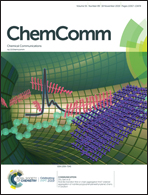Structure evolution from Prussian-blue nanocubes to hollow nanocage composites via sodium tungstate etching†
Abstract
The formation path of hollow complex nanocages prepared via Na2WO4·2H2O etching, using Prussian blue as a template, is tracked, which confirms the existence of a central cross structure inside the etching products. A mechanism based on etching along edges is described. The gas sensor designed with an Fe–W hollow complex exhibits excellent performance toward CH3S3CH3.



 Please wait while we load your content...
Please wait while we load your content...